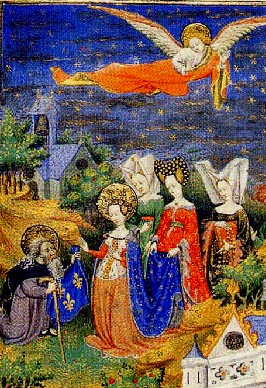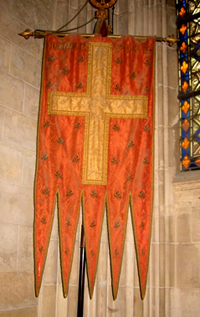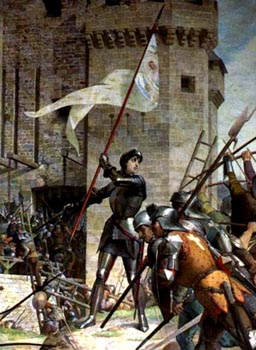 |
Symbolism
Red, White and Blue
Hugh O’Reilly
This article aims to show that the colors of the French flag – considered one of the modern symbols that originated in the French Revolution – in fact have a richer meaning that comes from old French customs and a Catholic tradition that stretches back centuries. Often, when we find something beautiful in the Revolution, even when presented as original, it was robbed from the Church and Christendom.
The blue cape of St. Martin
Blue is the oldest color of France. After the conversion of Clovis on Christmas 496, the army of the Franks took up the custom of placing itself under the protection of the relics of the Saints. According to tradition, during the Battle of Vouillé, near Poitiers, in Spring of 507, Clovis ordered the blue cape of St. Martin to be brought to the army camp. The Franks were victorious over the Visigoth King Alaric II and attributed their victory to the protection of the Saint.

Clovis receives the blue banner
Bedfood Book of Hours |
This relic was kept in a chest that the king placed in a private oratory not far from his own quarters. From this came the name chapel (the French chapelle, from chape, which means cape). This name was given to the oratory that housed the cape of St. Martin and the chaplains [chapelains] were the religious who guarded it.
Since it was not convenient for the reliquary to be taken into combat, blue standards and banners were made symbolizing the cape of St. Marin to be carried into battle.
The cape of St. Martin is held by tradition as being present at the celebrated Battle of Poitiers in 732, a turning point in History when Charles Martel expelled the Saracens from France. Its presence is also noted at other battles – in 838 at the Battle of Tours, and in other battles in 1043, 1066, and 1195.
A blue banner also appeared in a mosaic of the Church of St. John Lateran that shows the coronation of Charlemagne by Pope Leo III.
The blue banner inspired the blue background used in the banner of the Valois kings. The Valois banner was of blue material, strewn with gold fleur-de-lys, and first used by Louis VI (1108-1137). Later Charles VI (1380-1422) reduced the number of fleur-de-lys to three, in honor of the Holy Trinity.
Red – The insignia of St. Dionysius
At the beginning, the oriflamme was the standard for the Church of Saint Denis in Paris. It was used in memory of the city’s first Bishop, St. Dionysius, who was beheaded. A consequence of the annexation of the County of Vesein – where Saint Denis is located – to the crown was the annexation of the Oriflamme to the royal symbols.

The red oriflamme in the Church of Saint Denis in Paris |
When the King of France fought in wars he used as a symbol a red gonfalon that was called the oriflamme of St. Dionysius.
Louis VI, having become procurator of Saint Denis, that is, the one charged with defending that Church, decided in 1124 for the first time that the Oriflamme would be carried in the battle against the German Emperor Henry V, who was preparing to take Rheims. The Emperor died before he could enter into combat, and the French attributed this unlucky incident to the special protection of the Oriflamme of St. Dionysius.
Between 1124 and 1386, the Oriflamme was carried in four Crusades and 17 wars. Philip Augustus placed a red cross over his armor when he left for the Crusade in 1188, inspired by the color of the Oriflamme.
This insignia also had a religious character, and a special ceremony, The Blessing of the Oriflamme, was carried out before it was carried into battle. First, the relics of St. Dionysius were exposed publicly before the army. The King came and knelt before the insignia, and then confided it to a knight chosen from among the bravest. This knight solemnly swore to carry it into combat and to never abandon it, come what may. The other knights then kissed the Oriflamme.
At the hour of battle, the chosen knight, preceding the King, wore the Oriflamme across his chest. But when he arrived before the enemy troops, he fixed it onto the point of a gilded lance to carry it high before the enemy.
Various illustrations representing the Oriflamme show a long red banner with three to eight tails, and the words of Montjoie or St. Denis, along with embellishments of gold flames or stars.
White – White crosses and white banners

Jeanne d'Arc at the siege of Orleans carrying her standard, a white field sown with lilies |
During the War of 1413 between France and England, the knights of Armagnac took a white cross as its symbol, inspired by the coat of arms of the Duke of Orleans. He had adopted the white cross in opposition to the red cross worn by their enemies, the Burgundians and the English.
When Charles VII ascended the throne of France, he added the white cross of the defenders of the royal cause against the English to the fleur-de-lis standard.
Some years later, St. Joan of Arc in her marvelous epopee took as a symbol of the French army a white standard sown with fleurs-de-lis. This standard always accompanied her, notably at the anointing of Charles VII as King in the Cathedral of Rheims in 1429. On that occasion, she told him with pride, “It was present in the heat of the battle, therefore it is right that it be present in the hour of glory.”
The white color became the color of command, and in 1638 the white banner became the banner of the king, the general commander of the army.

Translated and adapted from Miroir de L’Histoire, n. 152, October 1962
Posted February 9, 2008

Related Topics of Interest
 The Middle Ages, a forest filled with symbols The Middle Ages, a forest filled with symbols
 The four beasts of the Gospel The four beasts of the Gospel
 Requiescant in pace... Burial customs Requiescant in pace... Burial customs
 The symbol of the sword The symbol of the sword
 Refuting anti-Catholic lies about the Middle Ages Refuting anti-Catholic lies about the Middle Ages
 Gargoyles and original sin Gargoyles and original sin
 Vice and vice symbolized in animals Vice and vice symbolized in animals
 Votive light, fire and candles Votive light, fire and candles

|
Symbolism | Religious | Home | Books | CDs | Search | Contact Us | Donate

© 2002- Tradition in Action, Inc. All Rights Reserved
|
 |
|